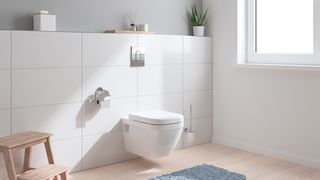What is a rimless toilet? Why they can be more hygienic and quieter
Rimless toilets are touted as more efficient, hygienic, and quieter than traditional designs. Here we explain why as well as how they are different to other toilet styles

生态革新者和房屋建筑商可以找到的东西themselves asking ‘what is a rimless toilet?’ as they seek out ways to reduce their water consumption and use of chemical cleaning products.
Toilets are a vital part of the home – for obvious reasons – but the importance of its functionality and design appeal often go unthought of.
Here, we go into the benefits and drawbacks of rimless toilets, taking into account hygiene, cost, noise, and other factors.
For more insight, read our extensive article about the various differenttypes of toilet.
What is a rimless toilet?
A rimless toilet is simply a toilet that does not have a traditional rim. Instead of water flowing into the bowl around the rim, they have a direct flush technique that funnels water around the edge of the pan, which is smooth.
Many people also consider them more aesthetically pleasing than traditional toilets, which largely have had the same design andtoilet dimensionsfor decades. The efficient flush technique also uses less water.
There are two main types of rimless toilet: back to wall and wall-hung. Wall-hung toilets are attached to the wall, which means no contact with the floor. The cistern and pipework are located inside the wall cavity, giving it a minimalist and modern look, like with this Grohe wall hung rimless toilet (pictured above)available with concealed cistern at B&Q.
Back to wall sit flush against the wall like traditional toilets, with no gap between the toilet pan and the wall, making cleaning easier. You can also find close-coupled rimless toilet but generally these tend to be of more contemporary rather than traditional style. You can find out more about 'what is a close-coupled toilet?' in our guide.

Why are rimless toilets more hygienic?
The absence of a thin, enclosed rim makes rimless toilets easier to clean and more hygienic than a traditional toilet, because limescale and germs don’t build up. This also means less cleaning products are required.
Tap Warehouse’s Tom Drake says cleaning the rim of a traditional toilet is tricky because it’s always too small to clean with a sponge, brush, or even a hygiene wipe or old toothbrush, and therefore it never feels like it has had a thorough clean.
Even when bleach is squirted in, you cannot really see where the chemical is going and parts of the rim are easily missed.
He said: “Think about how much easier it would be to clean if there was no rim. You could simply wipe in one smooth motion. There would be no need for any brushes and you can see exactly where you’ve cleaned.”
Not only is a rimless toilet easier to keep clean, it will stay more hygienic after every flush because the direct flush technique used by most rimless toilets shoots water around the entire bowl, whereas a traditional toilet may have spots the water doesn’t reach.

Are rimless toilets quieter?
一般来说,是的。不仅是无框的厕所sanitary than traditional ones, but they are also quieter thanks to their advanced designs and water-saving capabilities – some manufacturers claim they are 80% quieter than traditional toilets.
This is because rimless toilet technology often incorporates a superior flushing system. The water is propelled around the entire bowl horizontally, creating a powerful flush that is both efficient and effective.
What are the disadvantages of rimless toilets?
Wellsons’ bathroom blogger Anthony Jones rimless toilets sometimes have the possibility of splashback because there is no rim to block the swirling water.
Although rimless toilet manufacturers have taken steps to reduce splashing, it might still occur if it is not properly installed. For example, if the flush flow valve is not properly positioned, water splashing might ensue and create a mess in your bathroom. Install them with care or hire a professional to do it for you.
Rimless toilets also have a more complex manufacturing process, making them more expensive than their traditional counterparts. Most tend to hover around £200.
Jones adds: “As rimless toilets are a relatively new bathroom innovation, finding replacement parts may not be as straightforward compared to traditional toilets.”
If you are adding a toilet to your bathroom, take a look at our piece onfitting a toilet seatas well asbathroom design.

Get the Homebuilding & Renovating Newsletter
Bring your dream home to life with expert advice, how-to guides and design inspiration, direct to your inbox.
Sam is based in Coventry and has been a news reporter for nearly 20 years. His work has featured in the Mirror, The Sun, MailOnline, the Independent, and news outlets throughout the world. As a copywriter, he has written for clients as diverse as Saint-Gobain, Michelin, Halfords Autocentre, Great British Heating, and Irwin Industrial Tools. During the pandemic, he converted a van into a mini-camper and is currently planning to convert his shed into an office and Star Wars shrine.
Most Popular
Bring your dream home to life with expert advice, how-to guides and design inspiration, direct to your inbox.
Thank you for signing up to Homebuilding. You will receive a verification email shortly.
There was a problem. Please refresh the page and try again.

